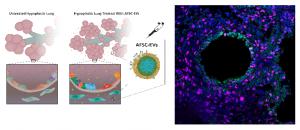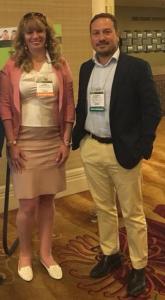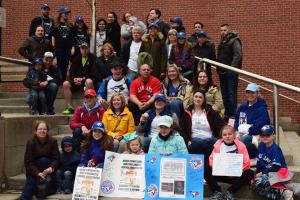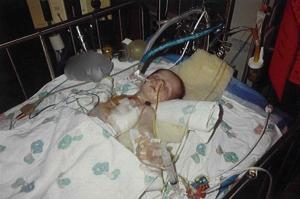Research team gives hope to 100,000’s of children around the world with new finding.
Charity cheers as research team uses exosomes from amniotic fluid stem cells to treat underdeveloped fetal lungs, restarting growth & normal functioning.
LONDON, LONDON, UNITED KINGDOM, May 20, 2021 /EINPresswire.com/ -- Charity cheers for an incredible breakthrough, as the international research team uses exosomes from amniotic fluid stem cells in animal models and human lung cells to treat underdeveloped fetal lungs, restarting growth and normal functioning.
The patient families at CDH International were shocked by the recent news that Dr. Augusto Zani and his team at the Zani Lab at the University of Toronto were able to grow fetal lungs in experimental models of CDH. The shock quickly turned into hope for the over 52,000 children worldwide every year with Congenital Diaphragmatic Hernia (CDH).
CDH occurs during gestation when the diaphragm fails to fully form often allowing abdominal organs to reach the chest cavity and restrict lung growth. There is a 50 percent chance of survival with CDH and the cause is still unknown. Treatment is surgery shortly after birth and a long recovery for those who survive. This new research will make it possible to regenerate those damaged lungs before the baby is born, giving these children a much better chance at survival.
While the promising finding is still in its experimental stage, Dr. Augusto Zani and his team have been moving on to human samples to test how well their therapy works. The next steps are to test their therapy in large animal models, then in a small cohort of patients with CDH.
This research was supported by CDH International in a long supportive relationship between the Lab and the charity, which has helped secure research funding for Dr. Augusto Zani and his team.
“We are very excited about this potential therapeutic option for CDH, a devastating disease that currently does not have an effective and widely available antenatal treatment. The unwavering support of CDH International was critical for us to not only spread the word and reach thousands of CDH families but also to keep us motivated and inspired to push the research forward” said Dr. Augusto Zani.
“When Dr. Zani shared the lab’s findings, we were just floored. We knew what he was researching, had so desperately hoped that they would be successful, and after all of these years of bated breath with so many research centers teasing hope… it has finally arrived. I truly believe that this is the beginning of the end of Congenital Diaphragmatic Hernia and I could not be more hopeful for these children and more proud of our charity’s tiny role” says CDH International President, Dawn Ireland.
“This really is a miracle. That’s not an overstatement. The Zani Lab has achieved what CDH researchers have tried to do for decades – find a way to grow lungs restricted by Congenital Diaphragmatic Hernia.”
"This breakthrough means answered prayers for future babies to have a better chance at a healthy life," says Lynne Brogdon, mother to CDH survivor, Baer Brogdon.
Kimberly Job, a mother to Alexandria who did not survive CDH, had this to add to the discussion; "The work accomplished by Zani Lab gives an epic and eternal hope to families who have been, or will be dealing with this devastating and possibly detrimental birth defect!"
Ximena Arroyo, whose daughter, Rosalie is a CDH survivor says "Zani Lab’s breakthrough means more; more hope, more survivors, more possibilities for the CDH community".
"Such an amazing breakthrough! This will give so much more hope to families with newly diagnosed CDH babies, so they can be given the best chances at life before they're even born!" added Deirdre McKenna, who lost her son to Elliott to CDH and is part of a global network of patient families at CDH International.
CDH is classified as a rare disease but it’s a fairly common birth defect. The economic cost of CDH on families and governments is astronomical. Now, Covid-19 has taken much of research funding too and research is suffering across the board. Our kids feel invisible because the world doesn’t see them but then incredible people like those at the Zani lab keep working for our children and accomplish something so big… It really gives our patient families hope. Not just our 100,000’s of children with Congenital Diaphragmatic Hernia but numerous other birth defects and medical conditions as well” says Ireland.
“It’s real hope for CDH and that’s something this community has never truly had”.
CDH International first began work in the UK in 1995 and is now a registered NGO out of London (Registered UK Charity no. 1189819). They also have registered NGOs in the United States, Switzerland, the Netherlands, Singapore and Hong Kong and are the world's oldest and largest charity for Congenital Diaphragmatic Hernia, running the global patient registry and collectively raising over £3,000,000 for the cause. They also work closely with many other CDH charities in the Alliance of Congenital Diaphragmatic Hernia Organizations (ACDHO), EURORDIS, Rare Diseases International, the Global Initiative for Children's Surgery and projects with the World Health Organization, the National Institutes of Health (in the United States) and other research entities. If you would like to learn more or to donate to help these children, please visit http://www.cdhi.uk
Learn more about this research at: https://stm.sciencemag.org/content/13/590/eaax5941/tab-article-info
Dawn Ireland
CDH International
uk@cdhi.org
Visit us on social media:
Facebook
Twitter
LinkedIn
First use of exosomes as fetal therapy using animal models and human lung cells by Zani Lab.
Legal Disclaimer:
EIN Presswire provides this news content "as is" without warranty of any kind. We do not accept any responsibility or liability for the accuracy, content, images, videos, licenses, completeness, legality, or reliability of the information contained in this article. If you have any complaints or copyright issues related to this article, kindly contact the author above.





